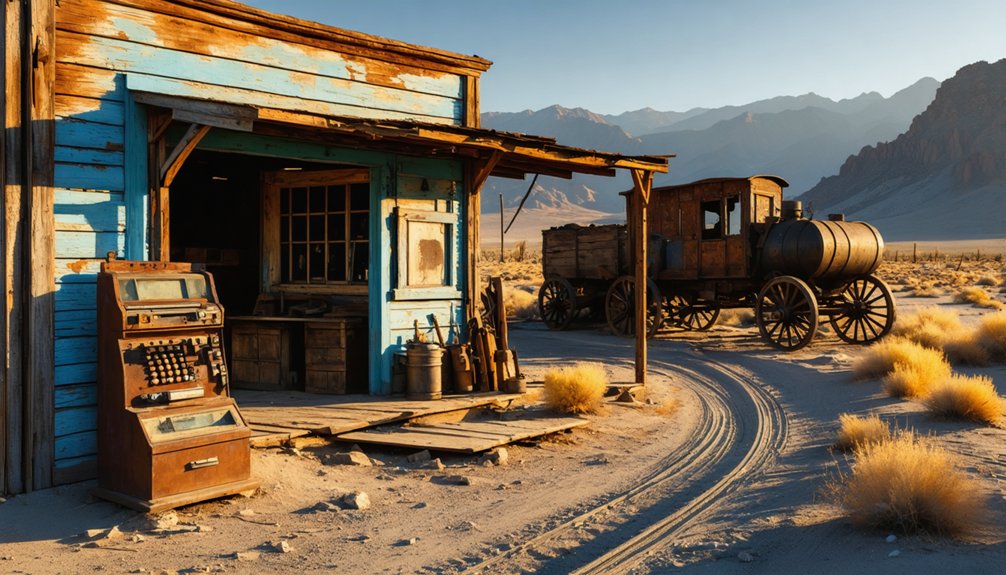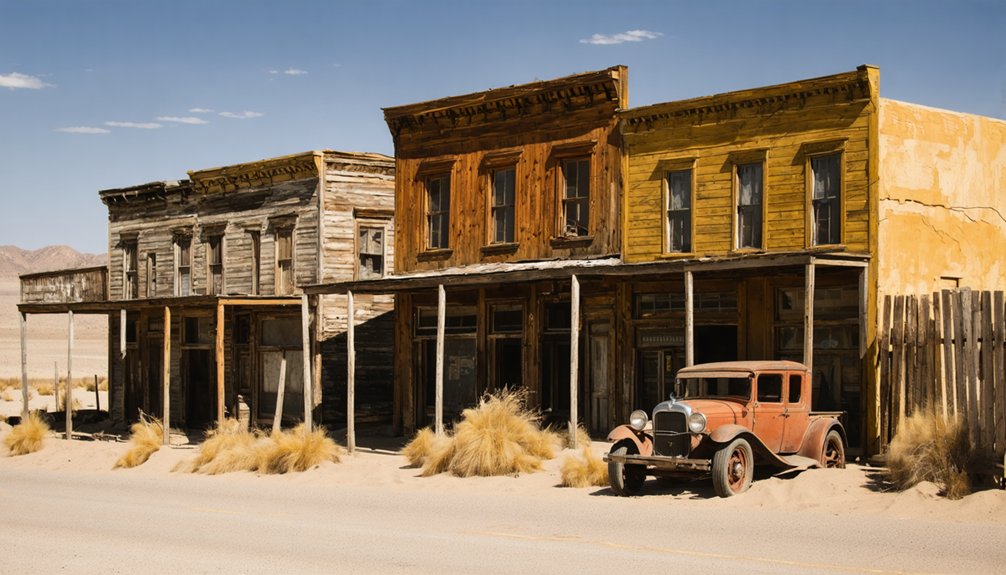Sodan transformed from wilderness to thriving gold mining settlement in the late 1850s, attracting diverse fortune seekers who established Victorian-fronted businesses. As surface gold diminished, miners adopted complex extraction methods until deposits were exhausted in the 1860s. The town’s final decline came with silver mining’s collapse in the 1890s, with the post office closing in 1899. Today, you’ll find roofless buildings and mining relics amid supernatural lore about restless spirits still searching for gold.
Key Takeaways
- Sodan transformed from a wilderness to a bustling mining camp after gold discovery in the 1850s before being abandoned by 1900.
- The ghost town’s demise resulted primarily from exhausted gold deposits and the collapse of silver mining operations.
- Remaining structures include roofless employee housing, a schoolhouse, store, church, and various mining equipment.
- Access to Sodan requires suitable vehicles for rough terrain, with no formal paths, signage, or guided tours available.
- The site is surrounded by supernatural folklore including stories of miners’ spirits, a ghostly woman, and unexplained phenomena.
The Rise and Fall of Sodan During the Gold Rush
When gold was discovered near Sodan in the late 1850s, it triggered a rapid transformation of this Sierra Nevada foothill area from uninhabited wilderness to bustling mining camp.
You’d have witnessed fortune seekers flooding in, establishing a diverse community within months. The economic fluctuations were dramatic—businesses sprouted to serve miners, with saloons and general stores defining Sodan’s commercial district. Similar to many websites today, visitors to Sodan needed to accept certain essential features to participate in the town’s economy.
The frenzied arrival of gold-chasers transformed barren hillsides into a thriving marketplace almost overnight.
Community dynamics evolved as schools and churches emerged, signaling a settlement that hoped to last. Initially, miners used simple panning techniques before transitioning to more complex mining methods as surface gold became scarce.
However, by the early 1860s, easily accessible gold deposits were exhausted. Without economic diversification, Sodan couldn’t sustain itself.
The population that had surged so quickly began to disperse by the late 1860s, leaving abandoned buildings as silent evidence to the ephemeral nature of Gold Rush prosperity.
Daily Life in a Mining Frontier Town
The harsh realities of Sodan’s decline became evident in the abandoned structures, but before its demise, daily life in this frontier town revolved around the grueling demands of gold extraction.
You’d rise before dawn to work long hours with pick and shovel, traversing perilous terrain that claimed many lives, especially in winter.
Your daily routines extended beyond backbreaking labor. Though initially sparse, Sodan soon featured Victorian storefronts housing French restaurants, bakeries, and diverse cuisine options—a stark contrast to early provisions of mere bacon. These establishments mirrored Julian’s transition from mining-focused saloons and supply stores to more diverse businesses serving the permanent settlement. Similar to Silverado, the town quickly developed to include multiple hotels and stores, creating a bustling main street for residents and visitors alike.
Community gatherings centered around saloons and public houses where you’d share stories after shifts. Opera houses, theaters, and competitive ski races offered respite from mining’s hardships.
Families, not just male miners, formed the social fabric as Sodan evolved from rough camp to established town.
Notable Buildings and Landmarks
Visitors to Sodan today encounter only weathered remnants of what once constituted a thriving mining community, though historical records provide detailed accounts of its architectural landscape.
The town’s main street showcased simple yet functional architectural styles, with rectangular layouts and gabled roofs characterizing most structures. You’ll find the schoolhouse foundation and chimney among the most preserved features—this 1890s building served as the heart of community gatherings for decades. Like many ghost towns in California, Sodan stands as a testament to the economic cycles and resource depletion that shaped the state’s development. Similar to Bodie, the town remains in a state of arrested decay, preserving the authentic feel of its abandonment.
Key structures that defined Sodan’s character:
- The two-story boarding house where prospectors exchanged tales of fortune
- The general store and saloon built from local timber and stone
- The blacksmith shop that kept the mining operations functioning
The town relied on imported water, evidenced by remnants of the water tower and pump house still visible today.
The Mysterious Abandonment of Sodan
As you explore Sodan’s abandoned streets, you’ll encounter the mystery of its rapid depopulation that occurred between 1895-1900 when most residents fled within months.
The collapse of silver mining operations, triggered by ore depletion and crashing global silver prices, stands as the primary cause rather than the occasionally rumored natural disaster theory.
Records confirm this economic devastation left no alternative industries to sustain the isolated desert community, creating the ghost town you see today. Like many other ghost towns in California, Sodan’s history represents the boom-and-bust cycle that characterized early settlement patterns throughout the state. The miners endured impoverished conditions while pursuing elusive fortunes that rarely materialized for most workers.
Sudden Mass Exodus
When Sodan’s population vanished in the late 1890s, historians initially struggled to explain the abrupt departure that left buildings intact yet eerily vacant.
Community dynamics and economic shifts tell the real story—declining silver prices triggered a collapse that rippled through Sodan’s fragile economy.
The exodus followed a predictable pattern seen in other ghost towns:
- First, mine operations scaled back, causing workers to seek opportunities elsewhere.
- Then, supporting businesses—saloons, general stores, boarding houses—failed in rapid succession.
- Finally, the post office closed in 1899, officially marking Sodan’s abandonment.
You can still see evidence of this sudden departure in the hastily abandoned homes, where personal belongings were left behind by residents who couldn’t transport them to their next destination. This pattern mirrors what happened in Saltdale, where the post office closure in June 1950 signaled the town’s official end.
The town’s isolation after railroad rerouting sealed its fate. Like many other California ghost towns, Sodan represents the boom and bust cycles that characterized the state’s development throughout its history.
Natural Disaster Theory
While historical records point to economic factors behind Sodan’s abandonment, a competing theory suggests natural disasters played a significant role in the town’s demise.
You’ll find evidence supporting this in the devastating floods of the 1970s, particularly Hurricane Kathleen (1976), which inundated shoreline communities and destroyed essential infrastructure.
The environmental impact was equally catastrophic. Agricultural runoff poisoned the Salton Sea with pesticides, fertilizers, and salt, triggering massive fish and bird die-offs by the 1970s.
As the lake receded, toxic dust spread throughout the region, creating serious health hazards.
These natural disasters, combined with the fundamental hydrological instability stemming from the 1905 Colorado River breach, transformed what was once a thriving destination into a contaminated wasteland that residents had no choice but to flee.
Mining Industry Collapse
The mining industry’s sudden collapse in Sodan represents the most compelling explanation for the town’s mysterious abandonment in the late 1960s.
While specific historical records about Sodan remain elusive in available documentation, the pattern likely mirrors other California mining communities that vanished when extraction became economically unfeasible.
Mining towns throughout the region faced similar fates when:
- Primitive mining techniques couldn’t compete with industrial-scale operations elsewhere
- Dwindling ore quality created unsustainable economic impacts on local businesses
- Rising operational costs coincided with falling mineral prices in the post-war economy
Without confirmed historical sources on Sodan specifically, this analysis represents a research gap that deserves further investigation.
The truth about this ghost town’s final days may still lie buried in local historical archives or state mining records yet to be uncovered.
Visiting the Ruins Today: What Remains
Visitors arriving at Sodan today will encounter a haunting tableau of deterioration and neglect rather than a carefully preserved historical site. Your journey requires traversing challenging access roads with a suitable vehicle capable of handling rough mountain terrain.
As you explore the ruins, you’ll discover scattered remnants of what once was: roofless employee housing, a schoolhouse, store, and church stand incomplete among the rubble.
Mining relics including flywheels, crushers, and adits punctuate the landscape, telling silent stories of industrial ambition.
The desert canyon setting, with its distinctive “hole in the wall” formation, creates an eerily picturesque backdrop as vegetation reclaims abandoned streets.
During your ruin exploration, exercise caution—no formal paths exist, structures are unstable, and limited signage means you’ll need prior research to fully appreciate this forgotten chapter of California’s mining history.
Preservation Efforts and Historical Significance

Unlike more prominent California ghost towns that enjoy protected status and organized preservation initiatives, Sodan exists in a preservation limbo, receiving virtually no formal recognition or protection.
This absence from historical registers presents significant preservation challenges, as the site continues to deteriorate without intervention from state agencies, historical societies, or community groups.
The historical relevance of Sodan remains largely undocumented, with no:
- Official historical markers or heritage designations
- Academic studies or thorough documentation
- Community-led restoration or educational programs
You’ll find no guided tours, commemorative events, or preservation grants directed toward this forgotten settlement.
The town’s omission from California’s ghost town inventories further compounds its obscurity, leaving Sodan’s story untold and its physical remains unprotected from the elements and potential vandalism.
Local Legends and Ghost Stories
While Sodan’s physical preservation remains neglected, its spiritual presence has grown in local memory through a rich tapestry of supernatural lore.
When you visit, you’ll encounter stories of miners who perished in accidents, their restless spirits continuing their search for gold through spectral phenomena like disembodied pickaxe sounds echoing at night.
You’ll hear about ghostly encounters with a woman in period dress wandering near the former general store, and a phantom dog barking from abandoned mine shafts.
The ruins come alive with tales of shadowy figures moving at dusk and unexplained lights flickering in empty windows.
These stories persist through generations, transforming Sodan into a magnet for paranormal investigators and creating a powerful mystique that keeps locals away after dark.
Frequently Asked Questions
Who Was the Town’s Most Famous Resident?
You won’t find information about Sodan’s most famous resident in available records. Research into Sodan history and famous residents remains incomplete in current California ghost town documentation.
What Indigenous Tribes Inhabited the Area Before Settlers Arrived?
Ever wonder who called this land home first? You’d find the Serrano, Cahuilla, and Tongva (Gabrielino) tribes inhabited the area. These Native Tribes held profound Historical Significance, managing resources through sophisticated seasonal practices.
Were Any Movies Filmed at Sodan’s Ruins?
You won’t find any documented movies filmed at Sodan’s ruins. Unlike other ghost towns that became popular film locations, Sodan’s remoteness and lack of ghost stories kept Hollywood’s cameras away throughout cinematic history.
What Happened to the Gold Mine’s Original Owners?
A million dreams shattered when John Sutter and James Marshall—the mine ownership pioneers—faced historical decline as miners invaded their land, stripped their wealth, and left them destitute despite kickstarting California’s transformation.
Is Camping Allowed Near the Sodan Ghost Town Site?
You can’t legally camp at Sodan itself. Instead, you’ll need to follow camping regulations at nearby campgrounds like Calico Ghost Town Regional Park, where you’ll find established facilities and permissions.
References
- https://www.kootenayrockies.com/partner/sandon-museum/
- https://worldawayfromhome.com/bodie-americas-best-ghost-town/
- https://www.camp-california.com/california-ghost-towns/
- https://dornsife.usc.edu/magazine/echoes-in-the-dust/
- https://en.wikipedia.org/wiki/List_of_ghost_towns_in_California
- https://www.youtube.com/watch?v=bz6XtozCSMg
- https://thevelvetrocket.com/2011/12/18/california-ghost-towns-scales/
- https://www.cbsnews.com/video/the-haunting-remnants-of-americas-ghost-towns/
- https://en.wikipedia.org/wiki/Sandon
- https://www.khanacademy.org/humanities/us-history/the-gilded-age/american-west/a/the-gold-rush



